Viva La Revolution – The story of Homefront and Dambuster Studios
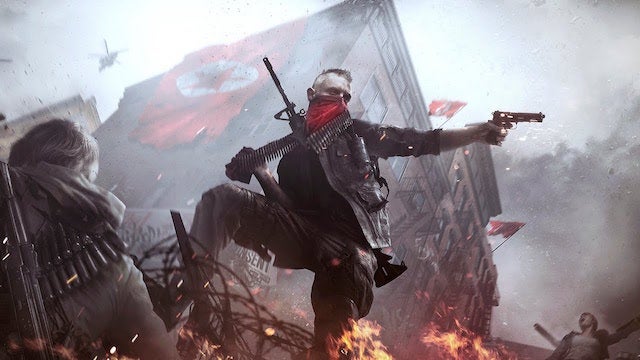
Due out this week, Homefront: The Revolution and its studio Dambuster Studios have survived a tortuous road to release. Brett Phipps reveals all.
The story of Homefront: The Revolution is one as fascinating as its alternate reality narrative: a five-year development cycle, including completely scrapping work two years in, and going through multiple discerning periods where this game was at great risk of never seeing the light of day. It’s been quite the journey and one not for the faint-hearted. To get a perspective of what it was like on the inside, I sat down with narrative designer Stephen Rhodes and studio and game director Hasit Zala to discuss the past, present and future of Homefront.
With The Revolution kicking off in less than a week, there was a palpable intensity throughout the studio, with potentially hundreds of thousands of people soon to be judging five years of work in 140 characters or less. The only comparable feeling was a group of students waiting for exam results.
“I try not to think about it too much,” says Rhodes, “but it starts to build up and you’re like ‘reviews are going to start dropping soon’, and people are going to start having it and opinions are going to start popping up and it’s all very nerve-racking.”
Buy Homefront: The Revolution from Amazon
The sentiment is matched by Zala, naturally, probably even more so. This has been his baby for five years, and he’s ridden every high and climbed every low.
“It’s a very kind of nervous anticipation. I mean we get a very kind of warped perspective of the game,” he says. “The whole focus of external QA teams is to bring to our attention aspects of the game which are not at the standard it should be, or problems or blockers or issue. So faced with that on a day-to-day basis you get a very distorted perspective of the game.
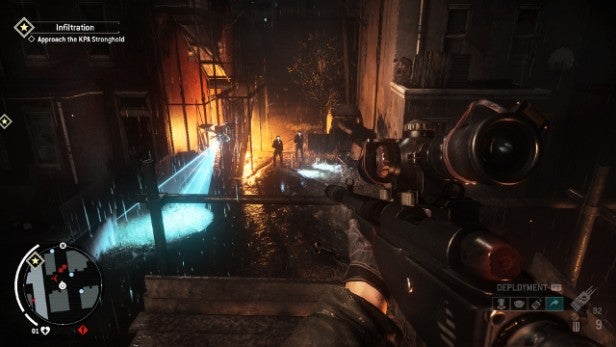
“From our side we’re too close to the game and probably have a very skewed perspective of it and we look forward to having objective people review the game and we’re nervously anticipating the reception it’ll get.”
Related: Doom review
In order to appreciate what this studio has gone through, it’s important to understand the road taken.
THQ announced a sequel to 2011’s Homefront – which received, at best, a mixed reception – in 2012. The first game’s developer – Kaos Studios – was shut down in 2011. As a result, Crytek UK was handed the reins.
Then begins a long spell of proverbial meeting fan: THQ filed for bankruptcy in December 2012. Many IPs were left in limbo. An auction soon took place with many popular franchises – Kingdoms of Amalur, Homefront, Darksiders, Red Faction, Destroy All Humans and others – being bought by different publishers. Imagine an episode of Bargain Hunt, only with far more interesting items for sale, and probably a lot more check shirts. It is the games industry, after all.
Crytek snapped up the rights to Homefront for just over half a million dollars.
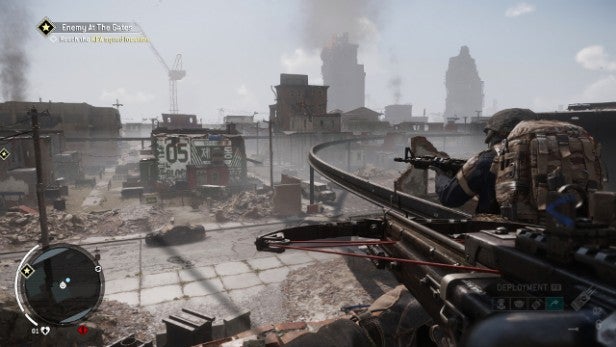
With Crytek UK developing a now Crytek-owned IP, things should be settled, right? Not quite. In mid-2014, it was announced that Deep Silver (another bidder in the THQ auction) would co-publish the game with Crytek. This was the first sign of trouble.
Reports began to surface that Crytek was running into financial difficulty, with wages unpaid to staff. This led to employees – Hasit Zala among them – to depart, leaving the future of Homefront back in jeopardy.
Related: Everything you need to know about PS4K
A month later Crytek would sell the Homefront IP to Koch Media, parent company of Deep Silver. Development of the game was then handed to a newly-formed team: Dambuster Studios. Formed of predominantly ex-Crytek UK employees, work could continue and the game survived.
Amidst all this uncertainty, the game itself underwent its own revolution. The first two years of Homefront ‘2’ saw development of a direct sequel to its underwhelming predecessor. But as publishers played hot potato with the IP, the studio was presented with an opportunity.
“The game starts off as a game that THQ ask us to develop and we work on it and back then the idea was to make a more expansive game but it was still a linear game,” Hasit tells me when I ask about that crucial period two years into development.
“Perhaps we were making larger maps with more player agency than Homefront 1, but it was still a linear game,” he adds. “When Crytek acquired the IP after the demise of THQ, there was an opportunity to do a full 360 review of the product and the title and I think the feeling was that they really wanted to push the innovation and ambition of the game.
“I’d always sort to make not just an open world game, but also something that really kind of maximised the power of modern hardware and consoles, so trying to move away from very rigorous scripted run and gun to something that was much more emergent, sandbox with player agency at the heart of it.”
Related: Civilization 6 news and rumours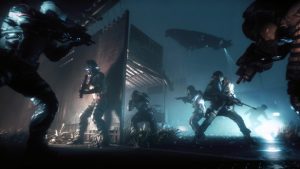
Despite the incredible gamble, being presented with the chance to tear up the rulebook and pitch a whole new idea to a publisher with faith in the studio was something Zala couldn’t pass up.
“At the heart of it was trying to give the player something that had a lot more freedom and immersion.”
‘Open world Half-Life’
Zala goes on to note the overarching philosophy for the game, what its inspirations are, and the answer certainly took me by surprise.
“The vision was to do an open world Half-Life. That’s what we set out to do.”
As you can imagine, saying that hallowed name to any publisher, they’re going to be captivated, but then reality set in.
“When we first pitched it to the studio, they were very excited,” Zala continues, “and then about two weeks afterwards they went ‘oh my god this means an awful lot of work and a lot of challenge and ambition’.
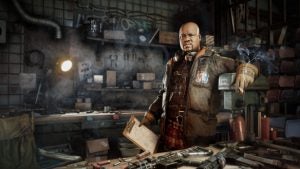
Considering the amount of investment already sunk into the game at this point, I ask Zala if there was any scope to finish work on the direct sequel before beginning work on what we now know to be The Revolution.
“No, I think we were at a point whereby we would either spend a year or so finishing Homefront or we would be going down the path we did. And we were supported in that decision to create and innovate and do something a bit more exciting.”
Hasit’s feelings towards the original Homefront are peppered in each statement of his excitement for The Revolution, but I ask him his thoughts on the predecessor outright, and the reception it got.
“I have to be careful I guess because you kind of learn within the industry that you have to be respectful of the efforts of everyone because it’s always hard to understand why a product doesn’t meet its expectations, and what other factors that go into it.
“I would say my biggest criticism for that game was that it was a very formulaic model, it was very much a linear, scripted shooter. That’s completely different from what we wanted to do, we wanted something that had lots of player agency, lots of immersion, lots of emergence in the gameplay and a sandbox narrative. But something that was very narrative [driven] and compelling. We never really particularly focused on Homefront 1 [for The Revolution], we very much focused on our vision of an open world Half-Life game.”
The idea of a narrative is something that Zala has pushed hard, and was arguably one of the few strengths of the original game. But the team has built a spiritual successor rather than a direct sequel, in order to build a more believable alternate reality, and that’s where Stephen Rhodes comes in.
Related: Overwatch Preview
Interestingly, for a game with such a big focus on ‘story’, The Revolution had just one narrative writer until Rhodes’ arrival last October, with only six months left of development. In a thirty hour campaign, that’s a hell of a lot of work.
“Alex, the other writer, was the only other writer until I came on board. So he was handling everything, and I still to this day have no idea to this day how he coped. With how big the story is, and how big the game is, and all of the narrative elements that get worked.
“I think from a narrative point of view we essentially doubled the writing resources in those last six months.”
Rhodes joined the team with a strong pedigree, having left CD Projekt Red, where he was working on The Witcher 3. But arriving so late in development meant he faced some tough calls.
“It’s difficult when you come to a new project and you’re like ‘this needs improvement and this bit needs improvement’, because people have been working on it for two and a half years, and I come in and say this bit needs to be better, but it was stuff that everyone agreed needed to be better.”

It’s incredible to discover just how much work has been done in the final six months of development, particularly from a narrative perspective.
“It’s changed massively since when I got here. I remember playing it that first week and getting a feel for the project and getting a feel for the cutscenes and the direction and I look at it now and there’s so many emotions about where it is, and where it’s come from, and I’m so proud of it and how it’s changed.”
I ask Rhodes what was in most need of ‘fixing’ upon his arrival.
“I think the main key factor was time. The pieces were all there, and everything that was there was of a certain level of quality. Nothing is right the first time, any creative will tell you that. It’s just, there’s always a need for iteration, I think it just needed that iteration.
“The heavier scenes that were rewritten and re-worked and re-adjusted were scenes that were kind of legacy from how the game was right at the beginning. Because they were two years into development of a game, and so they were doing mo-cap and doing recordings and scripts for it and then, the game changed, but you don’t really want to get rid of everything that you worked on before so it’s like ‘what can we include and how do we include that?’ And it was kind of that stuff that needed to be re-worked and re-tweaked to fit the new direction and the new theme.”
Related: Watch Dogs 2 latest news
The studio recently announced its promise to stick with The Revolution for at least a year post-launch, with DLC which has been worked on “for a number of weeks now” according to Rhodes.
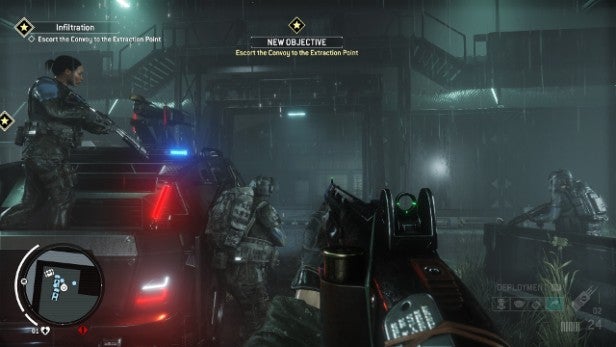
With a large number of people sinking six years into one project, I ask Stephen if there’s any possibility of fatigue, if anyone has grown tired of the world of Korean-occupied America, and if there’s a desire to move on to the next thing.
“I’ve always got constant ideas running through my head. I’m also writing another game, for an indie studio, friends of mine, I’m doing that at the same time and I’ve also got books on the go, film screenplays, so I just put my ideas into other things. I think most creatives are the same, it’s like you’re creative, you do the ideas you want to do at work and then anything else that doesn’t fit into that remit you do outside of work and you always have to be creative or you just get bored, I think.”
Rhodes goes on to note that it helps when your work fuels creativity, unlike his previous experiences.
Related: PS4 vs Xbox One
“I’ve been on that side, because I’ve worked at Traveller’s Tales and made a Lego games for four and a bit years, and that’s a very limited creative space because there’s so many template pieces you have to adhere to and that used to drive me mad,” he says. “Whereas here, where I get to be incredibly creative and have quite a lot of creative control over the ideas we put in, it does gratify me a lot more, and I think that the people who are still here after all this time are people who also feel like they get that here. I think that people who didn’t or doesn’t have that is probably already gone at this point.”
The studio director also shows no signs of his passion for Homefront waning.
“We’re fully committed to the development of Homefront,” Zala tells me, “we’re pretty excited with where we are. We’re already creating DLC, and we’ve already committed to free online development for a year, so we’re hoping to really work with the community and public to really shape something they’re excited for, as well.”
This, however, is also tapered with the persistent reality of what’s to come, and the rapidly-approaching court of public opinion will ultimately dictate the future of this franchise.
“So for us we’re going to take stock a little bit and see what the reaction is, what people want, we’ve got DLC that we’re developing, we have many ideas within the franchise and what we’re doing but we really need to see what people’s reactions are.
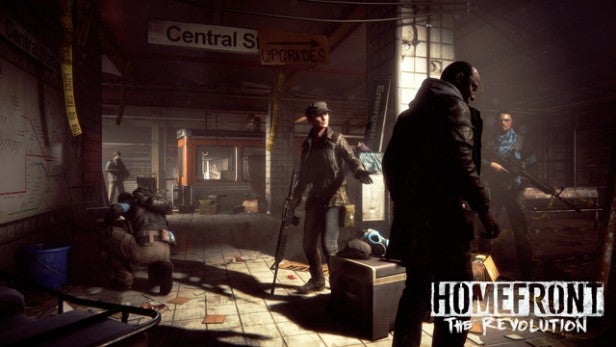
“Based on that and once we’ve had time to assess it then we’ll be in a position to assess beyond that, but right now our focus is very much on the product and how it’s received and what we’re going to do in the immediate future to support it.”
Whatever the future holds for Homefront, the studio in Nottingham can be proud of its persistence and bravery. To have a project of two years and be willing to completely overhaul it for an (incredibly ambitious) concept you believe in takes guts, and clearly it has legs: three different publishers invested in this project.
The Revolution is more than a name. When all seemed lost, Zala and his team kept fighting. Perhaps the mere fact that this game exists as a retail product is victory in itself. But clearly the coming week will be decisive and it’ll be interesting to see what comes next for this incredibly-resilient Dambuster Studios.


